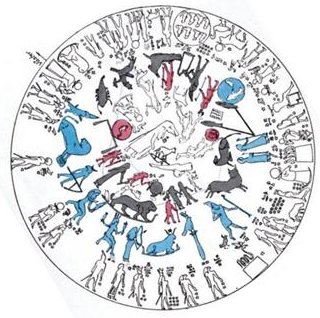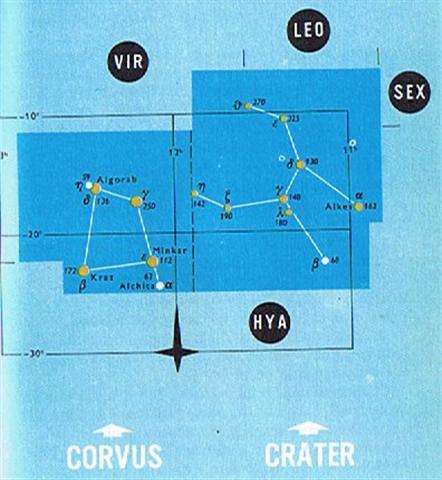The text of Q has only 736 glyphs, which I have read as 368 days. The cycle of time as presented by the text of G is probably 472 days long. This number of days can now be explained not only as a consequence of 16 * 29.5 = 472 (and half that, 8 * 29.5 = 236 days, coinciding with the cycle of Venus, cfr at niu) but also by referring to the distance to the Golden Age. Because the long stretch of Pisces makes it easy to state that a 'quarter' has elapsed since the Golden Age. 471 (the number of glyphs in G) - 91 (= 364 / 4) = 380 is quite close to 13 * 29.5 = 383½ (Roto Iri Are). I suggest the kuhane stations from Roto Iri Are up to and including Hanga Takaure (16 * 29.5 = 472) are representing a dark 'quarter' alluding to the dark ages between the present and the Golden Age. 4 out of 16 stations is equal to ¼. I will also take the opportunity to clearly state that the 'backward' moving time sequence beginning with Khnum in the Dendera zodiac presumably is representing the Hydra constellation, a kind of water serpent associated with Moon - with its head in the east and its tail in the west. The Egyptians identified it with the Nile (according to Allen). Also this sequence (beginning with Khnum and ending with Satit) has 4 signs out of a total of 16. The hole in pare in *Qa2-40 could therefore possibly be identified with the head of Hydra (because Metoro has told us that vai, water, should be drawn like a hole).
Furthermore, it seems possible to associate this pare with Rano Kau: ... They all climbed to the top of the hill. They climbed up on the tenth day of the month of June ('Maro'). They reached the side crater (te manavai) and looked around carefully. Makoi said, 'This is the Manavai of Hau Maka'. They climbed farther and reached the top. They saw the dark abyss and the large hole (of the crater Rano Kau). They all said, 'Here it is, young men, the dark abyss of Hau Maka.' They made camp and constructed a house. Kuukuu got up, worked the ground, and heaped up the earth for the yam roots ... The '10th of the month of June' refers to solstice twice, not only because of June but also because of 10 (presumably a clue hinting at the number of months of Sun). A dark (watery) abyss is opening up 'ahead'. June literally would be winter solstice, but the meaning could equally well be 'the month of summer solstice'. Poko could be alluding to puoko (head) and Te Poko Uri could refer to Rano Kau (cfr at haati).
8 kuhane stations later comes Hatinga Te Kohe. Half a year (measured as 16 kuhane stations) have passed. Counting 8 'blue' figures forward in time (clockwise) from the one with his staff 'broken' (at Pisces) we come to Khnum, which seems to be an Egyptian variant of Kuukuu. Down at the bottom of the crater lake there is no light (and Easter Island is down in the 'water'). Virgo once stood at summer solstice (north of the equator) and at her could have been a 'dark hole' (maybe Corvus or Crater) to plant 'yams' in:
The location of the 'dark quarter' (after the 'collapse' of the Golden Age) could be in the 'sky' and then possibly represented by the 4 signs Scorpio - Aquarius (in winter north of the equator). Or it could be in the 'water', and then perhaps at Hydra (below Leo in his boat). The 'feathered serpent' in the sky apparently has a 'tanist' in form of the 'water serpent' down below. Roto Iri Are, I have suggested (cfr at hoea), is an 'incarnation' of Ophiuchus, the 'snake bearer' (the 13th and nowadays abolished zodiacal sign). This constellation occupies a place between and slightly above Scorpio and Sagittarius, where the Milky Way crosses the ecliptic. In the Golden Age it would have been at autumn equinox (north of the equator), but in our age it is a 'quarter' later and at winter solstice north of the equator. The constellation was also thought of as a 'stork' and beyond Roto Iri Are comes the 'baby', Tama:
13 * 28 = 364 and 13 * 29.5 = 383½. If we count with 32 days in a month we have 12 * 32 = 384 and the 13th month has been abolished (while Virgo remains a virgin). But somewhere in these surroundings the year must be ending, and then a new year must be arriving. With Hercules dying at summer solstice and his tanist taking over until winter solstice there should for symmetry reasons be two halfyears to consider, two points where the 'year' is ending and regenerated anew. Also the watery serpent Hydra should (like Ophiuchus) be a place for regeneration. At honui the stretch of time from Ga5-10 to the beginning of the back side was measured as 4 months:
In G, it seems, a time of regeneration comes at the end of side a (close to the end of Sun's 10 months, counted from winter solstice). If in a calendar north of the equator the end of the year is thought of to be followed by 4 dark 'incubative' months (which allude to the dark ages in the past), and if we have as an axiom that the birth of Sun comes with winter solstice, then, on Easter Island there should also be 4 dark months when winter solstice is approaching. 300 days (or 295 days, or some other similar number of days) counted from Gb6-26 could include 4 extra months (above those 6 which correspond to half a year). Then, next half year (another kind of 6 months) will be the time of the 'tanist' (Moon). The ecliptic is the path of Sun and our wellknown and familiar zodiac is solar, therefore the 'quarter' caused by precession should belong on the 'front side' of the year. The beginning of the 'back side' of the year evidently is characterized by a great 'hole' (as seen in the *Qa2-40 pare), which can be contrasted with its opposite during spring, viz. a 'staff'. The hole is a female property and watery, the staff is male and fiery. Haati (cfr Qa9-43) has no toes (because such contain 'fire' as the myth about Maui and Mahuika has told us).
|
||||||||||||||||||||||||||||||||||||||||||||||||||||||










